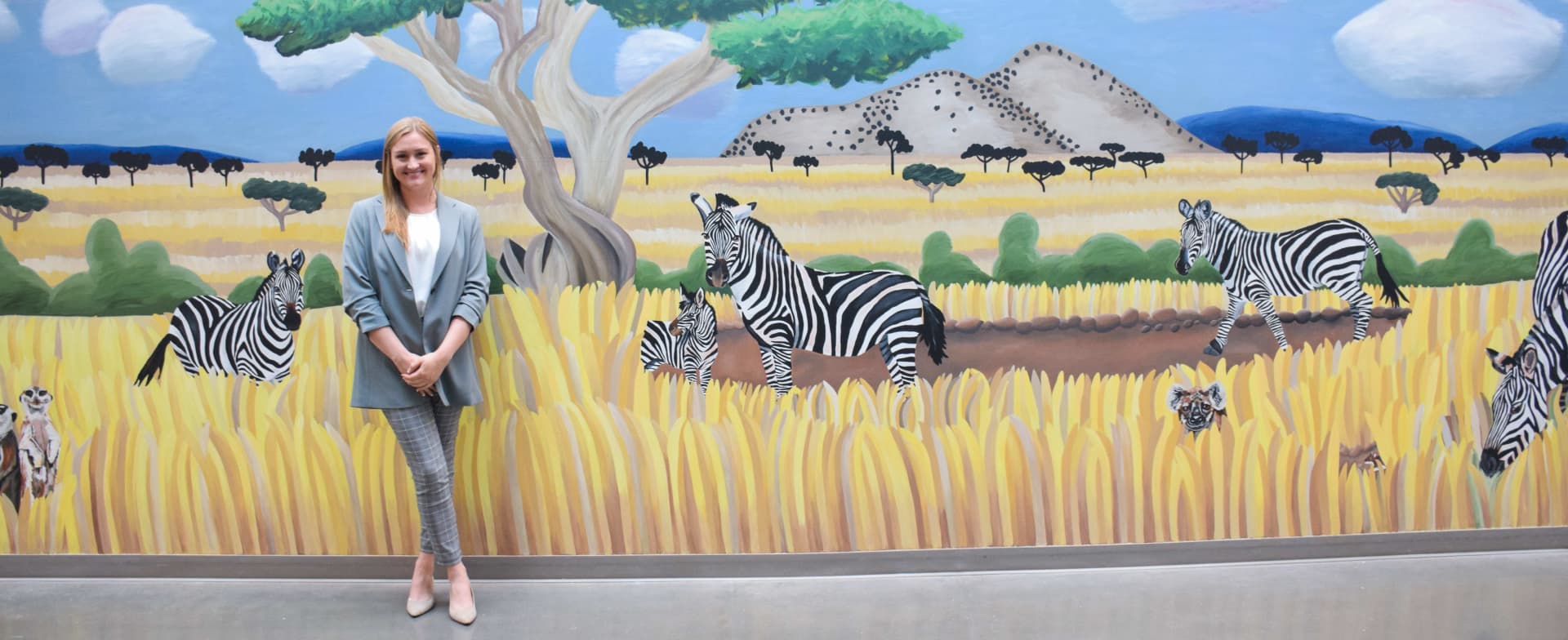An unusual mural honors rare disease patients | Takeda Stories

An unusual mural honors rare disease patients
Taylor Smith can’t count the number of times a passing colleague asked her why she was painting zebras.
It was summer of 2022, and Taylor was spending many evenings and weekends at our Covington, Georgia, site where we make plasma-derived therapies to meet the needs of patients with a variety of rare and complex chronic diseases. She works as a senior quality assurance specialist at this large manufacturing facility, but this project went above and beyond her day job — literally: she was painting a 19-foot wide by 13-foot tall (approximately 6-by-4 meter) mural depicting the African savanna in the building’s main corridor.
The Covington site’s leadership team had been looking for an innovative way to bring the facility’s commitment to patients to life while also brightening up the white walls.
When Taylor received a site-wide email asking if anyone wanted to paint a mural, she didn’t hesitate to volunteer. She also knew just what to paint. The Covington site produces plasma products for patients with primary immunodeficiency (PI) — a category of rare genetic disorders that impair the immune system. At an awareness walk for PI that Taylor attended in Atlanta, Georgia, in 2017, she learned that the official mascot for PI and many other rare diseases in the U.S. is the zebra.
“I’d never painted a mural before, but I’ve always been crafty with doing pet portraits,” she says. “I’m also a huge animal person. I said, ‘how about we do a safari scene with zebras that reflects our purpose but is also pretty and relaxing?’”
Covington’s Head of Site Communications Gabriel Khouli liked how Taylor’s idea references the well-known medical aphorism, “when you hear hoofbeats behind you, don’t expect to see a zebra1.” This expression applies to rare disease because zebras are rare in comparison to horses in the U.S.
“The reason the zebra is such a widely used mascot for rare diseases is because it gets to the root of the issue, which is that diagnosis takes so long,” Gabriel says. “In the U.S., the average time for an individual to receive a diagnosis of PI is estimated to take about 12 years2. There’s still so much work to be done, and we’re trying to help patients wherever we can.”
That’s why the zebra also reflects the site’s commitment to transforming patient lives.
“Using the zebra as a mascot in the U.S. is a brilliant way to raise awareness to the public and to physicians that these diseases may be rare, but they have common symptoms. The noise of the hoofbeats is the same, but it’s not the same animal.”
Martine Pergent, president of the International Patient Organization for Primary Immunodeficiency
From zebras to tapirs, astronauts and blue bears
While zebras represent PI patients in the U.S., mascots for the disease around the world reflect each country’s unique culture and illustrate distinct aspects of the disease. In Malaysia, the PI mascot is the tapir, an endangered animal that’s often confused with hippos, pandas or anteaters. In China, an astronaut is used to signify how important it is for PI patients to protect themselves from germs. And in France, the PI mascot is an adult blue bear, symbolizing patients’ strength and that PI is not just a pediatric condition.

Martine Pergent, president of the International Patient Organization for Primary Immunodeficiency
Martine Pergent, president of the International Patient Organization for Primary Immunodeficiency, says the mascots represent each country’s specific challenges in addressing PI.
“Discrepancies in diagnosis for PI around the world are huge3,” she says. “Most patients eventually receive a diagnosis, but there’s often a delay because the symptoms can be the same as for many other diseases. Using the zebra as a mascot in the U.S. is a brilliant way to raise awareness to the public and to physicians that these diseases may be rare, but they have common symptoms. The noise of the hoofbeats is the same, but it’s not the same animal.”
Feeling like a celebrity
Taylor estimates that she spent 150 hours painting the mural. The most challenging part was its sheer size. But the interactions she had with her colleagues made the experience worth it.
“Most people didn’t know that zebras are a symbol for rare diseases. I got to talk about it, it helped me spread the message and to meet a lot of my co-workers. It’s the most celebrity I’ve ever felt,” she says.
Now that the mural is finished, it has helped unify the site’s 1,300 employees and contractors whose shifts span 24 hours, seven days a week. Gabriel says it has become a must-see for site visitors and employees alike.
“When I bring in external groups, no one knows the significance of the zebra,” he says. “A lot of our employees come in new to the industry and they know the diseases we treat but don’t know a lot about them. The mural lets us tell that story in a different way. It gives you a visual, it gives you a story to tell.”
Taylor says her newfound celebrity has given her an opportunity to highlight our company’s long history of commitment to patients. This was evident when a patient group viewed the mural.
“Some of them became emotional and talked about feeling seen by the people making the medicine,” she says. “It reminds us all when we come to work and do the same thing every day, it reminds us why we’re doing it. It’s a visual reminder of the end goal of what we’re doing.”
References
National Library of Medicine. Rare diseases in general practice: recognizing the zebras among the horses. Published November 2016.
National Library of Medicine. Changing the Lives of People With Primary Immunodeficiencies (PI) With Early Testing and Diagnosis. Published June 25, 2018.
National Library of Medicine. Primary Immunodeficiencies: A Decade of Progress and a Promising Future. Published February 18, 2021.
Related Stories
Takeda’s focus on health equity: Rare Disease Day 2023

Share this story
